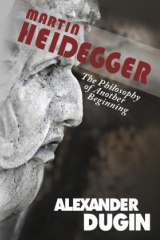TABLE OF CONTENTS
Part 1: Seyn und Zeit
Chapter 1: Encounter with Heidegger: An Invitation to Journey
Thinking and Its Authorities - Heidegger: Great or the Greatest? - M. Heidegger in the USSR: A Distant Shelf of the Special Collections and the Vain Efforts of Bibikhin - Heidegger as the Most Western of all the Western Philosophers - Heidegger and the Meta-Language of the New Philosophy - Heidegger's Silence - The Fortuity of Successes - The Philosopher as [an] Identity - To Think With Words: Indo-European Zones of Thinking - To Think Evening-ly
Chapter 2: Being and Beings
Differentiation ("Ontologische Differenz") - Das Sein and Das Seiende - It is Easy to Understand Beings: The Foundation of Thinking - Being is a Problem: The Leading Problem of Philosophy - "The Leading Question of Philosophy" was Formulated Incorrectly
Chapter 3: Fundamental-Ontology
The Complexity of Bezug - The Ontic – Ontology - To Fundamental-Ontology
Chapter 4: Das Seynsgeschichtliche
Die Geschichte and Seyn – The Message [Thrust] and the Leap - Seynsgeschichte as Participation in Being (Seyn) - Seyn Ist Zeit - Three Layers of History - Sein in the Ontological Section of History - Language and the Verb "To Be" in Seynsgeschichte
Chapter 5: The Beginning and End of Western European Philosophy
Why Evening? - The Great Beginning and the "Daimon" of the Philosophers - ΦΥΣΙΣ И ΛΟΓΟΣ - ΑΛΗΘΕΙA in the First Beginning - The Catastrophe of Platonism (Idea and Representation) - Heidegger and Christianity (Platonism for the Masses) - Descartes: The Science and Metaphysics of Modernity – Vorsetzende Durchsetzung – The Objectification of Things – Hegel: The Outburst of the “Big Logic” - Nietzsche and the End of Philosophy
Chapter 6: Heidegger's Seynsgeschichtliche Anthropology
Man’s Guilt - Techne (τὲχνη) as Western European Fate - Freedom and Will
Chapter 7: Another Beginning (Die Andere Anfang)
The Preconditions of Another Beginning - The Transition (Übergang) – Ereignis - The Last God - Man in Another Beginning (The New Humanism)
Chapter 8: Seynsgeschichte and the Political Ideologies of the 20th Century
The Fundamental-Ontological Method and the Domain of its Application - Americanism and the Planetary-Idiocy of the Liberals - The Metaphysics of Communism: Machenschaft - The Political Ideology of the Third Way
Chapter 9: Not-Yet
The Metaphysics of Delay - The Man of the Beginning
Chapter Ten: Heidegger as a Great Milestone
References
Part 2: Das Geviert
Chapter 1: Introduction to das Geviert
The Meaning of the Term "Das Geviert" - The Fourfold (Geviert) and Seyn-Being - The Composition of the Fourfold (of Geviert) - War in the Fourfold (Geviert) – Sky - Sky and World – Earth – Ouranogeomachy - The Gods of the Beginning - The Men of Geviert - The Wars of Gods and Men - "We Think of the Other Three" - To Cross Out Sein - Men and Gods as Neighbours - The Axis of Anthropotheomachy - Seyn-being as the "Between" - Geviert and Ereignis - The Thing (Ding) - The Thing and the Gifts of Geviert
Chapter Two: Geviert as a Map of the Beginning and a Retreat from It
The Desert Grows - The Idea Covers Sky - Earth Was Turned Into Matter - The Human Man - Ousted Gods - The Fate of the Intersection - Geviert and Scholasticism - Geviert in the Metaphysics of Modernity - Gestell as Fate - The Industrial Transformation of the Fourfold – Simulacra
Chapter Three: Geviert in Another Beginning
Geviert and the Horizon of the Future - Geviert as Goal (The Will to Decision)
References
Part 3: Dasein
Chapter One: The Three Stages of Development of Martin Heidegger’s Philosophy
Chapter Two: Dasein and the History of Philosophy (From the First Beginning to the End of Philosophy)
Dasein as a Flash of Illumination and as a Conclusion from Historical-Philosophical Analysis - The Conceptual Prerequisites of the Emergence of Dasein - Historical-Philosophical Proglomena to Heidegger’s Philosophy: The Pre-Socratics – Plato – Scholasticism - The Ontological Triangle - Ontological Transformations in the Philosophy of Modernity: The Rational Ontology of the Subject in Descartes - Empirical Ontology - Leibniz’s Monad - Kant’s Ontological Doubt - Fichte and Hegel: The Overcoming of Kantian Pessimism - Nietzsche – The End of Philosophy – Husserl
Chapter Three: Dasein and its Existentials
Introduction to Dasein - Da and Sein - Here-Being - La Realité Humaine - The Experience of Dasein as a Phenomenon of Language and as an Explosion - From Essence to Existence - Three Ontological Slices - Dasein as Being-Between - Dasein’s Existentials - In-Der-Welt-Sein (Being-in-the-World) - “Being-in” and “Being-with” – Concern (die Sorge) - Thrownness (Geworfenheit) – Foundness and Fear - Verstehen (Understanding) - Speech (Rede) – Stimmung
Chapter Four: The Inauthentic Mode of Dasein’s Existence
Dasein’s Authenticity and Inauthenticity – All-Penetrating Everydayness - Decay (Verfallen) – Gossip (Gerede) - Curiosity (Neugierigkeit) - Ambiguity (Zweideutlichkeit) – Fear as Flight - The Figure Das Man - Das Man as an Existential of Dasein
Chapter Five: Authentic Dasein
Being That Is “Here” And That Is - Spatiality as an Existential of Dasein - The “Who” of Authentic Dasein - Being Towards Death (Sein Zum Tode) - Conscience (Gewissen) - The Positivity of the Analytics of Dasein in Both Modes - Dasein and Sein
Chapter 6: Zeit-время and its Horizons
Introduction of the Expression “Zeit-время” - The Finitude of Zeit-время - Three Ecstases of Zeit-время
References
Conclusion: Heidegger and the Situation of Philosophy



